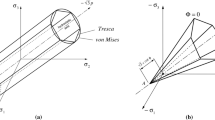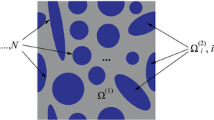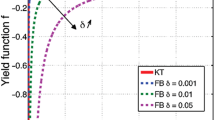Abstract
By expanding the yielding function according to Taylor series and neglecting the high order terms, the elastoplastic constitutive equation is written in a linear complementary form. Based on this linear complementary form and the principle of virtual work, a finite element-complementary method is derived for elastoplastic problem. This method is available for materials which satisfy either associated or nonassociated flow rule. In addition, the existence and uniqueness of solution for the method are also discussed and some useful conclusions are given.
Similar content being viewed by others
References
Maier, G., A quadratic programming approach to certain classes of nonlinear structural problems,Mechnica,3 (1968), 121–130.
Kaneko, I., Complete solutions for a class of elastoplastic structures,Comput. Struct. Appl. Mech. Eng.,21 (1980), 193–209.
Zhong Wan-xie and Zhang Rou-lei, The parametric variational principle for elastoplasticity,ACTA Mechanica Sinica,4, 2, (1988).
Zhang Rou-lei and Zhong Wan-xie, The numerical solution for PMPEP by parametric quadratic programming,Comoputational Structural Mechanics and Applications,4, 1 (1987). (in Chinese)
Sha De-song and Sun Huan-chun, A variational indquality of the virtual work principle and application in physically nonlinear problems,Computational Structural Mechanics and Applications,7, 2 (1990). (in Chinese)
Wang Ren, et al.,Elements of Plasticity. The Academic Press, (1987). (in Chinese)
Reklaitis, G. V., et al.,Engineering Optimization, Method and Applications, John Wiley & Sons, Inc. (1983).
Author information
Authors and Affiliations
Additional information
Communicated by Pan Li-zhou
The project is supported by the National Natural Science Foundation of China
Rights and permissions
About this article
Cite this article
Chang-ming, Z., Yong-jie, J. A finite element—mathematical programming method for elastoplastic problems based on the principle of virtual work. Appl Math Mech 14, 635–642 (1993). https://doi.org/10.1007/BF02455384
Received:
Issue Date:
DOI: https://doi.org/10.1007/BF02455384




